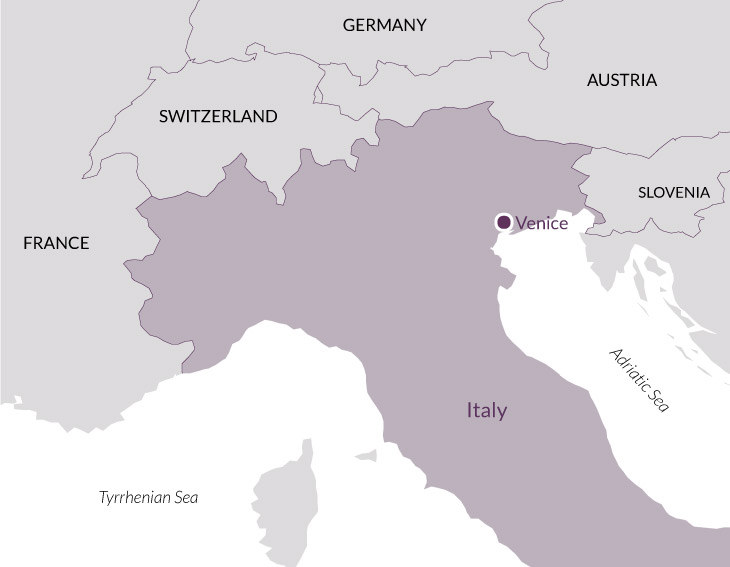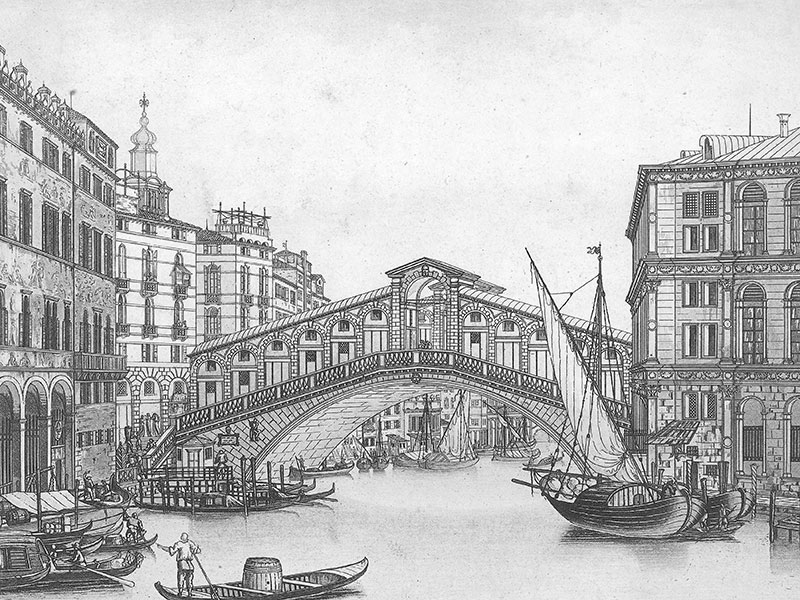Overview
For all its abiding grandeur, Venice is a small city. A walk from Piazzale Roma in the west to Sant’Elena on its eastern edge takes barely an hour. Yet each of its districts, the seven sestieri represented by the prongs of the metal forcola on a gondola’s prow, has its own indelible character and identity. Such robust individuality is mirrored by Venice’s history as a place of cultural ‘firsts’ in everything from the invention of the portable printed book and opera as a public art form to the use of forks at the dining table.
This distinctive world of ‘village Venice’, a unique urban narrative with the sestieri as its chapters, fascinates Jonathan Keates, a noted expert on matters Venetian and currently chairman of the Venice in Peril Fund – and a companion of staggering erudition on many matters historical, literary and artistic. As a walker in the city he loves to share his passion for the deeper townscape beyond Piazza San Marco, the Doge’s Palace and the Rialto.
In this quieter, less crowded world, mapped out by fifty-odd parish churches, he focuses on the wealth of detail which personalizes each cluster of campi and calli. We learn how to read the mesmerising Venetian text amid cloisters, courts and boatyards, in decorated well-heads, Byzantine paterae, Baroque ceilings and the essential physicality of brick and marble.
Fortunate indeed would be a participant on this tour who was a first-time visitor to Venice, given the mix of major masterpieces and rarely-seen crannies, all with the commentary of so distinguished a Venetianist. Equally it would suit people who already have some familiarity with the city. With this in mind, we would consider requests for this tour without accommodation for a reduction in price.
Day 1
Fly at c. 12.30pm (British Airways) from London Gatwick to Venice. Cross the lagoon by motoscafo (water taxi) to the hotel.
Day 2
The Dorsoduro, smallest and smartest of the sestieri. Starting from the great Baroque church of Santa Maria della Salute, visit the church of the Gesuati (Tiepolo ceiling), its Renaissance neighbour the Visitazione, San Trovaso (Tintoretto’s Last Supper and Michele Giambono’s St Chrysogonus) and a gondola boatyard. Campo Santa Margherita offers the complete story of Venice in buildings from the 12th to 20th centuries. Veronese adorned the church of San Sebastiano. Finally, Sant’Angelo Raffaele and San Nicolò dei Mendicoli, set in what was traditionally Venice’s poorest quarter.
Day 3
San Polo, Santa Croce. Antonio Fumiani’s amazing ceiling at San Pantalon, the world’s biggest painted canvas, begins the day. Then study the magnificent works by Tintoretto in the Scuola Grande di San Rocco before visiting the Franciscan basilica of Santa Maria Gloriosa dei Frari with its masterpieces by Titian, Bellini and Donatello. In the Scuola di San Giovanni examine the work of Renaissance sculptor-architects Mauro Codussi and Pietro Lombardo. Continue to San Giacomo dell’Orio, one of Venice’s oldest churches, and finish with the Baroque saloni in Palazzo Mocenigo.
Day 4
Castello. Two palaces tell contrasting stories: Querini Stampalia offers a patrician art collection in its original setting above a modern ground floor by Carlo Scarpa, while Palazzo Grimani, a Renaissance connoisseur’s Roman-style house with enchanting ‘natural history’ frescoes and magnificent Tribuna, has recently been recovered from its ruinous state. The Scuola di San Giorgio has the delightful cycle of paintings by Carpaccio, and San Francesco della Vigna an innovative façade by Palladio and works by Veronese and Bellini. The Basilica of San Giovanni e Paolo, the pantheon of Venetian doges, brings the afternoon to a close.
Day 5
Cannaregio. The flamboyant Gesuiti church, with its mock-brocade marble draperies, is the prelude to a walk in the quiet Cannaregio district and a visit to Venice’s Jewish ghetto. At the Madonna dell’Orto we admire epic Tintoretto canvases and enjoy the contrast, at Sant’Alvise, between works by Tiepolo and oddly moving 16th-century panels by primitive painters. The buildings of the Ghetto tell their own story of Jewish life in Venice over seven centuries. End at Ca’ d’Oro, the florid Gothic palace on the Grand Canal containing an important art collection.
Day 6
San Marco. In Campo Santo Stefano we look at the making of a Venetian ‘square’; the eponymous church has a roof like an upturned boat. Detour to Museo Fortuny for a Venice of early 20th-century art and fashion, and climb the unique Scala Contarini del Bovolo for a stunning roofscape. San Salvador offers outstanding High Renaissance architecture, while little San Lio contains beautiful sculpture of the same period. Explore the area around the home of Marco Polo and Teatro Malibran, and at San Giovanni Grisostomo see two of the city’s finest altarpieces, by Sebastiano del Piombo and Giovanni Bellini.
Day 7
Free morning. Travel by motoscafo to Venice airport. Fly to London Gatwick, arriving c. 5.45pm.
Price, per person
Two sharing: £3,040 or £2,890 without flights. Single occupancy £3,520 or £3,370 without flights.
Included
flights (Euro Traveller) with British Airways (Airbus 319); a vaporetto pass for the duration of the tour; travel by private motoscafo between the airport and hotel; hotel accommodation as described below; breakfasts; 1 lunch and 4 dinners with wine, water, coffee; all admissions; all tips; all taxes; a donation of £100 to the Venice in Peril Fund; the services of the lecturer and tour manager.
Accommodation
Hotel Palazzo Sant’Angelo: a 4-star hotel in an excellent location on the Grand Canal near Campo Sant’Angelo and the Rialto Bridge. Single rooms are doubles for sole use.
How strenuous?
Most of Venice is traversed on foot. Unavoidably therefore, there is a lot of walking – frequently up and down bridges. Standing around in churches, museums and palaces is also inevitable. The tour should not be attempted by anyone who has any difficulty with everyday walking and stair-climbing. Fitness is essential.
Are you fit enough to join the tour?
Group size
Between 8 and 18 participants.
Travel advice
Before booking, please refer to the FCDO website to ensure you are happy with the travel advice for the destination(s) you are visiting.

